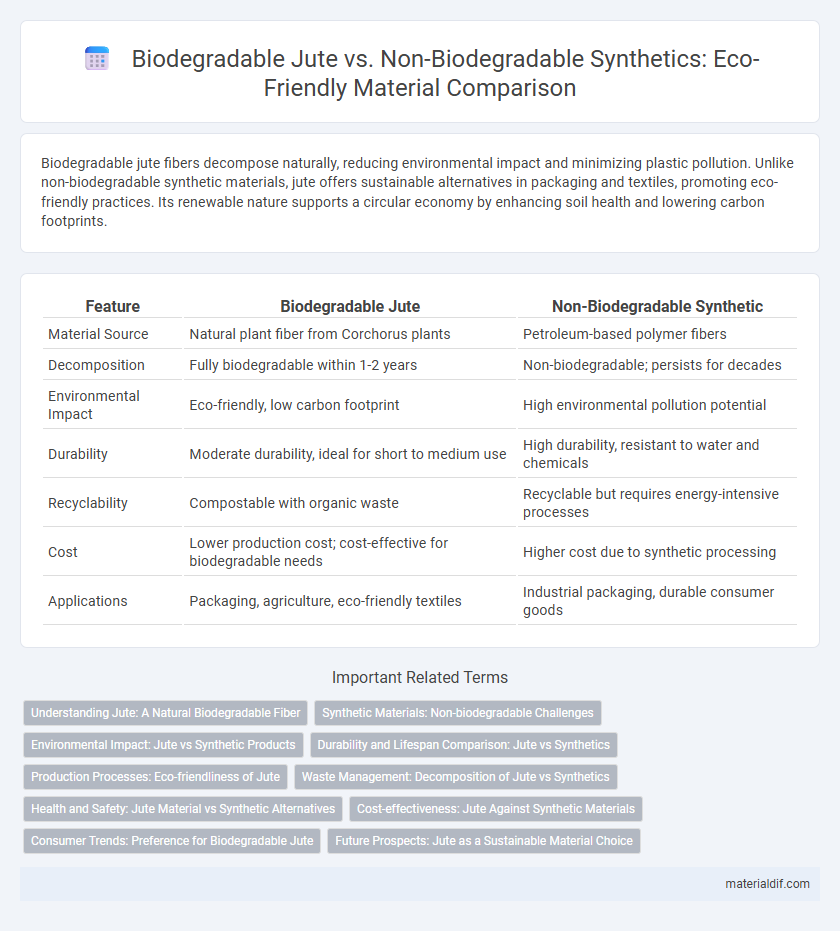Biodegradable jute fibers decompose naturally, reducing environmental impact and minimizing plastic pollution. Unlike non-biodegradable synthetic materials, jute offers sustainable alternatives in packaging and textiles, promoting eco-friendly practices. Its renewable nature supports a circular economy by enhancing soil health and lowering carbon footprints.
Table of Comparison
| Feature | Biodegradable Jute | Non-Biodegradable Synthetic |
|---|---|---|
| Material Source | Natural plant fiber from Corchorus plants | Petroleum-based polymer fibers |
| Decomposition | Fully biodegradable within 1-2 years | Non-biodegradable; persists for decades |
| Environmental Impact | Eco-friendly, low carbon footprint | High environmental pollution potential |
| Durability | Moderate durability, ideal for short to medium use | High durability, resistant to water and chemicals |
| Recyclability | Compostable with organic waste | Recyclable but requires energy-intensive processes |
| Cost | Lower production cost; cost-effective for biodegradable needs | Higher cost due to synthetic processing |
| Applications | Packaging, agriculture, eco-friendly textiles | Industrial packaging, durable consumer goods |
Understanding Jute: A Natural Biodegradable Fiber
Jute is a natural biodegradable fiber derived from the Corchorus plant, renowned for its eco-friendly properties and rapid decomposition in soil compared to synthetic fibers like polyester and nylon, which can persist for hundreds of years causing environmental pollution. Its cellulose-rich composition allows jute to break down naturally without releasing harmful toxins, supporting sustainable agriculture and reducing landfill waste. Emphasizing jute's biodegradability highlights its vital role in minimizing ecological footprints while promoting renewable resource use in textile and packaging industries.
Synthetic Materials: Non-biodegradable Challenges
Synthetic materials used in textiles, such as polyester and nylon, present significant non-biodegradable challenges due to their persistent plastic composition that resists natural decomposition. These materials contribute to long-lasting environmental pollution by accumulating in landfills and oceans, releasing microplastics that harm marine ecosystems and soil health. Unlike biodegradable jute, synthetic fibers exacerbate waste management issues, highlighting the urgent need for sustainable alternatives in the textile industry.
Environmental Impact: Jute vs Synthetic Products
Biodegradable jute products decompose naturally within months, significantly reducing landfill waste and greenhouse gas emissions compared to non-biodegradable synthetic materials like plastic, which persist for centuries. Jute cultivation enriches soil health through nitrogen fixation, whereas synthetic production relies on fossil fuels, contributing to environmental pollution and carbon emissions. The sustainable lifecycle of jute supports carbon sequestration and lowers ecological footprints, marking it as an environmentally superior alternative to synthetic fibers.
Durability and Lifespan Comparison: Jute vs Synthetics
Jute, a natural biodegradable fiber, offers moderate durability with a lifespan typically ranging from one to five years under optimal conditions, making it environmentally friendly but less long-lasting than synthetic alternatives. Synthetic fibers, derived from petrochemicals, provide superior durability and a lifespan often exceeding ten years, as they resist moisture, abrasion, and UV degradation more effectively than jute. However, the extended lifespan of synthetics contributes to environmental persistence and plastic pollution, whereas jute decomposes rapidly, reducing ecological impact despite lower durability.
Production Processes: Eco-friendliness of Jute
Jute production involves natural fiber extraction from Corchorus plants, requiring minimal chemical use and low energy consumption, highlighting its eco-friendly manufacturing process. Unlike synthetic fibers derived from petrochemicals through energy-intensive polymerization and extrusion, jute cultivation enhances soil health and reduces carbon footprints due to its renewable nature. The biodegradability of jute fibers allows waste decomposition without environmental pollution, contrasting sharply with synthetic materials that persist and contribute to microplastic contamination.
Waste Management: Decomposition of Jute vs Synthetics
Jute decomposes naturally within 2 to 6 months, releasing no toxic residues, making it an eco-friendly option for waste management. Synthetic fibers, derived from petrochemicals, can take hundreds of years to break down, often leaching harmful microplastics into soil and water ecosystems. The rapid biodegradation of jute significantly reduces landfill burden, supporting sustainable waste disposal practices.
Health and Safety: Jute Material vs Synthetic Alternatives
Biodegradable jute fibers naturally decompose without releasing toxic chemicals, making them safer for human health and reducing environmental hazards. In contrast, non-biodegradable synthetic materials often contain harmful additives and microplastics that pose respiratory risks and long-term ecological damage. Choosing jute over synthetic alternatives supports safer indoor air quality and lowers exposure to carcinogenic substances in manufacturing and disposal processes.
Cost-effectiveness: Jute Against Synthetic Materials
Biodegradable jute stands out as a cost-effective alternative to non-biodegradable synthetic materials due to its lower production and disposal expenses. Unlike synthetic fibers, which require expensive chemical processes and contribute to long-term environmental cleanup costs, jute's natural cultivation demands fewer resources and minimal waste management. The economic advantages of jute, combined with its environmental benefits, make it a sustainable choice for industries aiming to reduce both costs and ecological impact.
Consumer Trends: Preference for Biodegradable Jute
Consumer trends increasingly favor biodegradable jute over non-biodegradable synthetic materials due to heightened environmental awareness and demand for sustainable products. Jute's natural fiber composition enables rapid decomposition, reducing landfill waste and ecological impact compared to synthetic alternatives made from petrochemicals. Market analytics reveal a significant rise in consumer preference for eco-friendly packaging, fashion, and home decor items crafted from biodegradable jute.
Future Prospects: Jute as a Sustainable Material Choice
Jute, a biodegradable natural fiber, offers promising future prospects as a sustainable material compared to non-biodegradable synthetic alternatives like plastic and polyester. Its eco-friendly properties enable efficient decomposition, reducing long-term environmental pollution and enhancing soil fertility when discarded. Increasing global demand for sustainable packaging and textiles positions jute as a critical resource in transitioning towards circular economies and reducing carbon footprints.
Biodegradable Jute vs Non-biodegradable Synthetic Infographic

 materialdif.com
materialdif.com